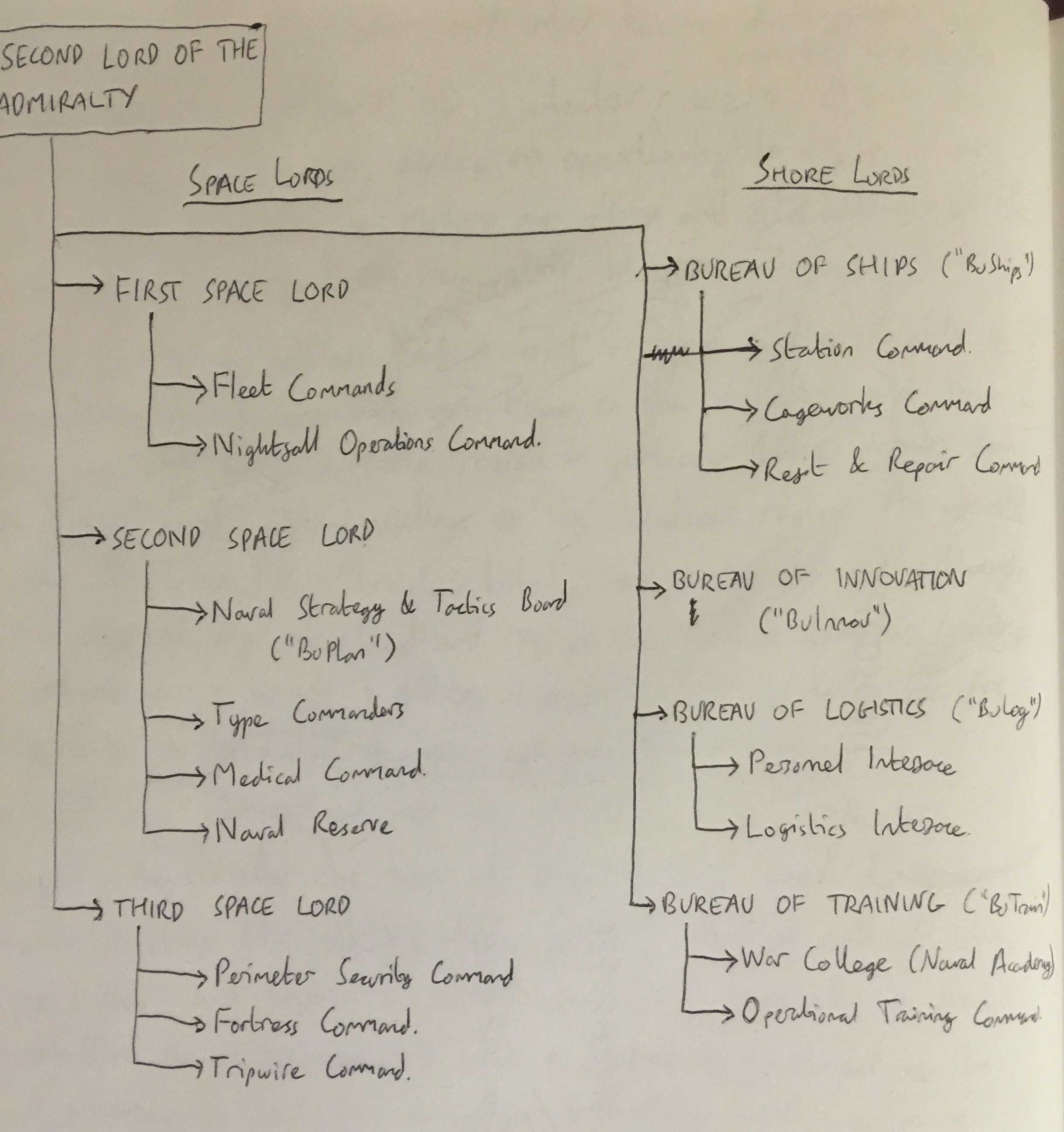So, as a preamble to other naval posts, let me take a moment to post some notes on the internal organization of the Imperial Navy that I’ll be referring to later.
(Pray pardon the hand-drawn diagram and dodgy formatting; I’m still at the con and posting from my smrtphn.)
At the top, you have the Second Lord of the Admiralty, whose function is – in conjunction with the other Lords of Admiralty – to formulate naval policy in the context of overall military policy. The rest of the organizational structure of the IN, while providing advice, is mostly purposed to implement said policies.
The top-level division is the semi-formal one between the Space Lords, whose responsibilities are for the Navy’s “teeth” – all that happens out in the black – and the Shore Lords, who are responsible for its “tail”, station-centered support functions.
The First Space Lord, almost always an Admiral of the Fleet, is responsible for overall strategic direction and the deployment of mobile units, through the Fleet Commands (for the Capital Fleet, the directional fleets, and so forth). While direct operational control in time of war is exercised through Core Command, its appointed Warmain (who commands all IMS units, not just IN ones), and his Theater Command, all under the First Lord of the Admiralty, these units belong to Fleet Command and the First Space Lord.
The First Space Lord also has direct control of the Nightfall Operations Command, which includes all those special units I could tell you about, but then I’d have to kill you and anyone else you might have spoken to in the interim.
The Second Space Lord is in charge primarily of doctrine development and operational planning, via the Naval Strategy & Tactics Board and the Type Commanders (who specialize in individual ship types) and their departments, collectively known as the Bureau of Planning (“BuPlan”).
They also control the Medical Command – which operates hospital and rescue ships, general medical functions being outsourced to IMS Medical under the Eighth Lord of the Admiralty – and the Naval Reserve.
The Third Space Lord commands the fixed defenses – Perimeter Security Command, which owns the Empire’s border-crossing stargaze garrisons, deep-space monitoring arrays, and anti-RKV systems; Fortress Command, which commands monitors, orbital defense grids, and other heavy fixed system defenses; and Tripwire Command, which controls various fixed monitoring satellites, primarily the Interface Defense Matrix at the edge of the Imperial Fringe and the Borderline Defense Matrix where the Worlds meet the Republic.
Among the Shore Lords’ departments, the Bureau of Ships (“BuShips”) deals with construction and support of the IN’s starships as materiel – incorporating Station Command, which includes all the IN’s space stations and satellites; Cageworks Command, which is shipyards and construction; and Refit and Repair Command, which coordinates maintenance, repairs, upgrades, and yard dog bitching about the state starships were brought to them in.
The Bureau of Innovation (“BuInnov”) is exactly what it says on the tin.
The Bureau of Logistics (“BuLog”) is, as its sub-org names imply, just a plug-in to the personnel and logistics services provided by the Eighth Lord of the Admiralty’s Stratarchy of Military Support and Logistics.
And the Bureau of Training (“BuTrain”) contributes training for the IN’s officers and men, including both the Naval Academy section of the Imperial War College, and the Operational Training Command, which coordinates extended post-Academy training aboard ship, and unit work-ups.
Those looking for conspicuous absences from this diagram will, at this point, have noticed both intelligence (Admiralty Intelligence is one step up, a peer of the IN as a whole, on the org chart) and legal functions (outsourced to the Watch Constabulary, the Office of Investigation and Pursuit, and/or the Three Departments of Impropriety as required, because they hate redundancy…)

